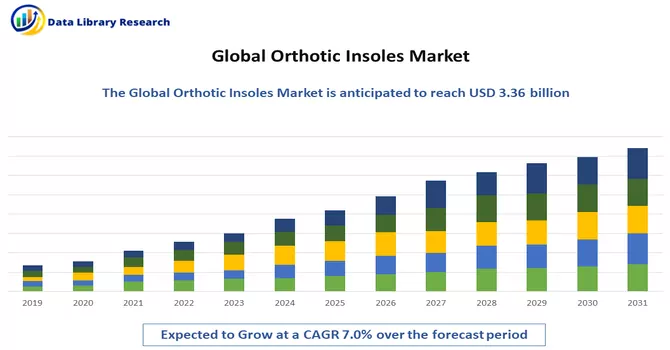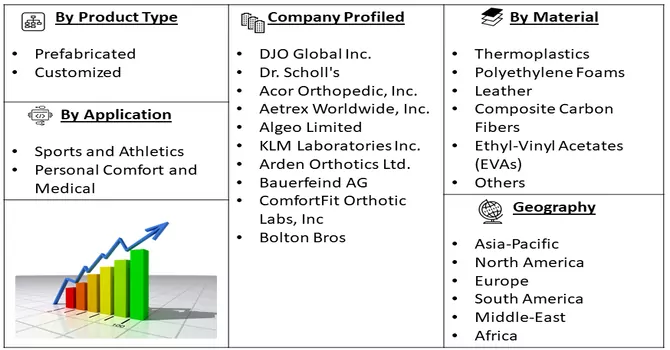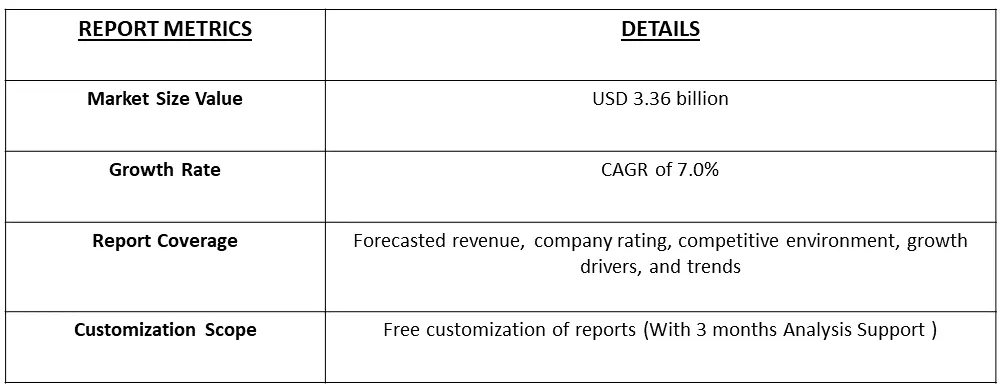The global foot orthotic insoles market, valued at USD 3.36 billion in 2022, is poised for substantial growth with a projected compound annual growth rate (CAGR) of 7.0% from 2023 to 2030.

Get Complete Analysis Of The Report - Download Free Sample PDF
Orthotic footwear refers to specially designed shoes or shoe inserts (orthotics) that provide support, stability, and alignment for the feet, ankles, and lower limbs. These footwear products are designed to address various foot conditions, alleviate pain, and improve biomechanical alignment. Orthotic footwear aims to promote proper foot function and reduce discomfort associated with conditions such as flat feet, plantar fasciitis, arthritis, and other foot-related problems.
One significant driver of market growth is the rise in the geriatric population. As individuals age, there is a heightened likelihood of foot-related issues and the need for orthotic solutions. The ageing population is thus becoming a major demographic contributing to the escalating demand for foot orthotic insoles. Moreover, the prevalence of chronic conditions like diabetes and plantar fasciitis is another influential factor stimulating market expansion. Individuals with diabetes often experience foot complications, making orthotic insoles instrumental in managing and preventing associated problems. Similarly, plantar fasciitis, a common cause of heel pain, has led to an increased awareness of the benefits of orthotic insoles for alleviating discomfort and promoting foot health. The anticipated growth in the market is indicative of the rising recognition of foot orthotic insoles as essential components in addressing various foot-related issues. As consumers become more conscious of the importance of foot health, the demand for these specialized insoles is expected to surge.
The ongoing advancements in materials and manufacturing technologies are leading to the development of more innovative and comfortable orthotic insoles. Features such as 3D printing, smart materials, and customization options are gaining traction, providing consumers with enhanced comfort and personalized solutions. Moreover, the growing interest in sports and fitness activities is boosting the demand for orthotic insoles among athletes and fitness enthusiasts. These insoles offer not only support and comfort but also aid in preventing injuries and enhancing performance, contributing to their popularity in the sports segment. The global orthotic insoles market is dynamic, with these trends reflecting evolving consumer preferences, technological innovations, and the healthcare landscape. As the market continues to adapt to these changes, stakeholders are presented with opportunities for growth and innovation.
Market Segmentation: The Foot Orthotic Insoles Market is Segmented by Product (Prefabricated and Customized), Material (Thermoplastics, Polyethylene Foams, Leather, Composite Carbon Fibers, Ethyl-Vinyl Acetates (EVAs), and Others), Application (Sports and Athletics, Personal Comfort and Medical), and Geography (North America, Europe, Asia-Pacific, Middle East and Africa, South America). The report offers the value (USD million) for the above segments.

For Detailed Market Segmentation - Download Free Sample PDF
Market Drivers:
Growing Foot Related Disorders
The increasing awareness of foot problems, notably conditions like plantar fasciitis and arthritis, has become a driving force behind the growing demand for specialized Orthotic Insoles as an effective solution. This heightened awareness is not only evident among consumers but is also underscored by the recommendations of healthcare professionals who recognize the importance of proper foot care. One key contributor to the rising demand is the aging population. As individuals age, they are more prone to various foot-related issues, including arthritis and general discomfort. A report published by HealthAging.org in February 2023 emphasized the significant impact of foot pain on the overall well-being of older individuals. The report highlighted the interconnectedness of foot pain with challenges in mobility, potentially leading to weight gain, weakness, and compromised heart function. The statistics provided by the article further underscore the prevalence of foot-related problems, with a staggering 87% of people experiencing painful feet at some point in their lives. This high incidence emphasizes the need for effective solutions to address the diverse range of foot disorders that individuals may encounter. As a result, Orthotic Insoles are increasingly recognized as a valuable intervention to alleviate discomfort, provide support, and enhance overall foot health.
Increasing Emphasis on Sustainability and Eco-Conscious Consumer Choices
The growing emphasis on sustainability and the rising tide of eco-conscious consumer choices are creating a unique opportunity for orthotic insole manufacturers to align their products with environmentally friendly practices. This shift in consumer preferences toward sustainability is not only a societal trend but also a key driver influencing purchasing decisions across various industries, including healthcare and personal wellness. The orthotic insole manufacturers can differentiate their products by adopting sustainable materials and manufacturing processes. By using eco-friendly materials, such as recycled or biodegradable components, manufacturers can appeal to consumers who prioritize environmental responsibility. This approach not only meets the ethical considerations of a conscious consumer base but also contributes to the overall reduction of the ecological footprint associated with product manufacturing.
Market Restraints
Limited Awareness About Orthotics Among Population
A significant portion of the population may not have received sufficient education or information about orthotics and their role in foot health. This lack of awareness stems from limited exposure to educational campaigns, public health initiatives, and general knowledge dissemination. Orthotic insoles are sometimes associated with specific medical conditions or seen as products exclusively for elderly individuals. These misconceptions create stereotypes that hinder a more widespread understanding of the diverse applications of orthotic insoles for various age groups and foot-related issues. Thus, owing to such factors, the growth of the market is expected to slow down the growth of the studied market.
The global orthotic insole market, like many other industries, has experienced significant impacts due to the COVID-19 pandemic. The pandemic has influenced various aspects of the market, from manufacturing and supply chain disruptions to changes in consumer behaviour and healthcare priorities. The pandemic has accelerated the adoption of digital health trends, including telemedicine and virtual consultations. This shift could impact the way individuals access information about foot health and orthotic solutions, potentially influencing consumer preferences and purchasing behaviours. Moreover, as the global community continues to navigate the challenges posed by the ongoing pandemic, the orthotic insole market is likely to adapt to the evolving landscape. Companies that can effectively address supply chain issues, leverage digital health trends, and align their products with changing consumer priorities may find opportunities for growth even in the face of these challenges.
Segmental Analysis :
Prefabricated Segment is Expected to witness Significant Growth Over the Forecast Period
Prefabricated orthotic insoles, also known as over-the-counter (OTC) orthotics, are pre-made foot inserts designed to provide support, cushioning, and relief for various foot conditions. These insoles are mass-produced and readily available without the need for a prescription, making them accessible to a wide range of consumers. The prefabricated orthotic insole market has witnessed steady growth due to factors such as affordability, convenience, and the rising awareness of foot health. The market may witness the development of prefabricated insoles with customizable components, allowing users to adjust certain features to better suit their individual needs. Thus, the prefabricated orthotic insole market continues to grow as awareness of foot health increases, and consumers seek accessible and affordable solutions. While customization remains a challenge, technological advancements and evolving consumer trends present opportunities for innovation in this segment of the orthotic insole market.
The Thermoplastics Segment is Expected to Witness Significant Growth Over the Forecast Period
Thermoplastics play a crucial role in the orthotic insole market, contributing to the development of advanced, customizable, and highly effective orthotic solutions. These materials offer a range of benefits, including moldability, durability, and the ability to provide tailored support to address various foot conditions. The integration of thermoplastics has significantly impacted the design, functionality, and overall performance of orthotic insoles. Thermoplastic insoles are commonly used in the treatment of plantar fasciitis. The ability to mould the insole to the contours of the foot provides targeted support to the arch and heel, alleviating pain associated with this condition. While highly effective, custom orthotic solutions using thermoplastics can be more expensive than mass-produced alternatives. Cost considerations may impact widespread adoption, especially in price-sensitive markets. Thus, the segment is expected to witness significant growth over the forecast period.
Sports and Athletics Segment is Expected to Witness Significant Growth Over the Forecast Period
The sports and athletics segment is poised for significant growth in the foreseeable future, outpacing other market segments. The prevalence of foot diseases among individuals involved in sports, often stemming from the pathophysiology of chronic conditions, has become a noteworthy concern. Notably, athlete's foot, also known as tinea pedis, is a common fungal infection affecting the skin on the feet. The extended use of footwear coupled with reduced aeration of the feet contributes to the occurrence of these disorders among athletes. Addressing foot diseases in the realm of sports often involves prolonged treatment periods, and in many cases, the use of insoles is recommended to expedite recovery and alleviate discomfort. This underscores the pivotal role of foot orthotic insoles in catering to the specific needs of athletes and individuals engaged in sports activities.
A notable article published in the Sports Business Journal in September 2022 shed light on the popularity of basketball in the USA. With 27.1 million players overall, it emerged as the second-most popular major sport in the country in 2021, surpassing baseball by 11.5 million players. The data revealed that eight million individuals identified as core hoopers, playing at least 13 times a year, more than double the number of dedicated baseball fans. This surge in the number of sports enthusiasts, particularly in basketball, indicates a higher likelihood of foot-related issues among players, thereby driving the demand for foot orthotic insoles. Thus, the sports and athletics segment is poised for robust growth, fueled by the high prevalence of foot diseases among individuals involved in sports and the escalating interest in sports activities globally. The demand for foot orthotic insoles is expected to surge as athletes and sports enthusiasts seek effective solutions to address foot-related issues and enhance their overall performance and well-being.
North America Region is Expected to Witness Significant Growth Over the Forecast Period
North America is poised to take the lead in the foot orthotics market throughout the forecast period, surpassing other geographical regions. The dominance of the market in this region can be attributed to several key factors, including a surge in orthopaedic illnesses, an increasing number of emergency cases, and the growing geriatric population.
A significant contributor to the market's growth in North America is the rising prevalence of diseases, with diabetes standing out prominently. The National Diabetes Statistics Report, published by the Centre for Disease Control and Prevention (CDC) in January 2022, presented alarming figures. In the United States alone, an estimated 37.3 million people were living with diabetes, out of which 28.7 million were diagnosed, including 28.5 million adults. Additionally, 8.5 million people were estimated to have undiagnosed diabetes, and 26.4 million individuals aged 65 (48.8%) were reported to have prediabetes. The elevated incidence of diabetes is a significant contributor to diabetic foot problems, creating a heightened demand for foot orthotic insoles in the foreseeable future.
Statistics from the 2021 census of Statistics Canada provide further insights. In 2021, Canada had approximately 7,021,430 individuals aged 65 years or older, with 3,224,680 being males and 3,796,750 females. Given the substantial size of the elderly population, a significant proportion is likely to experience health conditions such as diabetes, cardiac diseases, osteoporosis, or musculoskeletal issues leading to foot problems. Consequently, the increasing geriatric population is anticipated to be a driving force for market growth in the North American region. Thus, North America's dominance in the foot orthotics market is underscored by the region's growing prevalence of orthopedic and diabetic conditions, coupled with a substantial and aging population. These factors collectively contribute to an increased demand for foot orthotic insoles, positioning the region as a key driver of market expansion in the coming years.

Get Complete Analysis Of The Report - Download Free Sample PDF
The foot orthotic insoles market is marked by intense competition, where mid-sized and smaller companies are gaining prominence through strategic technological advancements and innovative product offerings. These companies are leveraging advancements in technology to introduce novel products, thereby expanding their market presence, often at more competitive price points. The emphasis on introducing new products at lower prices is a strategic move to make foot orthotic insoles more accessible to a wider audience. By offering competitive pricing without compromising on quality, mid-size to smaller companies are effectively addressing the diverse needs of consumers, including those who may be more price-sensitive. Some of the key market players working in this market domain are:
Recent Developments:
1) In February 2022, Foot Solutions, a leading retailer specializing in wellness footwear and personalized orthotic insoles, revealed its acquisition of Happy Feet Plus, an established retail company based in Florida.
2) In January 2022, Digitsole, a trailblazer in the digital health industry, officially unveiled its highly innovative second-generation product, the Digitsole Pro system, along with smart insoles, in the United States. This announcement marks a significant milestone for the company as it introduces advanced technology aimed at revolutionizing the realm of digital health and smart insole applications in the U.S. market. The Digitsole Pro system showcases the company's commitment to pushing the boundaries of innovation and delivering cutting-edge solutions in the field of wearable health technology.
Q1. What was the Orthotic Insoles Market size in 2022?
As per Data Library Research the global Orthotic Insoles market, valued at USD 3.36 billion in 2022.
Q2. At what CAGR is the Orthotic Insoles market projected to grow within the forecast period?
Orthotic Insoles is expected to grow at a compound annual growth rate (CAGR) of 7.0% over the forecast period.
Q3. What are the factors driving the Orthotic Insoles market?
Key factors that are driving the growth include the Growing Foot Related Disorders and Increasing Emphasis on Sustainability and Eco-Conscious Consumer Choices.
Q4. Which Region is expected to hold the highest Market share?
North America region is expected to hold the highest Market share.
Data Library Research are conducted by industry experts who offer insight on industry structure, market segmentations technology assessment and competitive landscape (CL), and penetration, as well as on emerging trends. Their analysis is based on primary interviews (~ 80%) and secondary research (~ 20%) as well as years of professional expertise in their respective industries. Adding to this, by analysing historical trends and current market positions, our analysts predict where the market will be headed for the next five years. Furthermore, the varying trends of segment & categories geographically presented are also studied and the estimated based on the primary & secondary research.
In this particular report from the supply side Data Library Research has conducted primary surveys (interviews) with the key level executives (VP, CEO’s, Marketing Director, Business Development Manager and SOFT) of the companies that active & prominent as well as the midsized organization
FIGURE 1: DLR RESEARH PROCESS

Extensive primary research was conducted to gain a deeper insight of the market and industry performance. The analysis is based on both primary and secondary research as well as years of professional expertise in the respective industries.
In addition to analysing current and historical trends, our analysts predict where the market is headed over the next five years.
It varies by segment for these categories geographically presented in the list of market tables. Speaking about this particular report we have conducted primary surveys (interviews) with the key level executives (VP, CEO’s, Marketing Director, Business Development Manager and many more) of the major players active in the market.
Secondary ResearchSecondary research was mainly used to collect and identify information useful for the extensive, technical, market-oriented, and Friend’s study of the Global Extra Neutral Alcohol. It was also used to obtain key information about major players, market classification and segmentation according to the industry trends, geographical markets, and developments related to the market and technology perspectives. For this study, analysts have gathered information from various credible sources, such as annual reports, sec filings, journals, white papers, SOFT presentations, and company web sites.
Market Size EstimationBoth, top-down and bottom-up approaches were used to estimate and validate the size of the Global market and to estimate the size of various other dependent submarkets in the overall Extra Neutral Alcohol. The key players in the market were identified through secondary research and their market contributions in the respective geographies were determined through primary and secondary research.
Forecast Model
